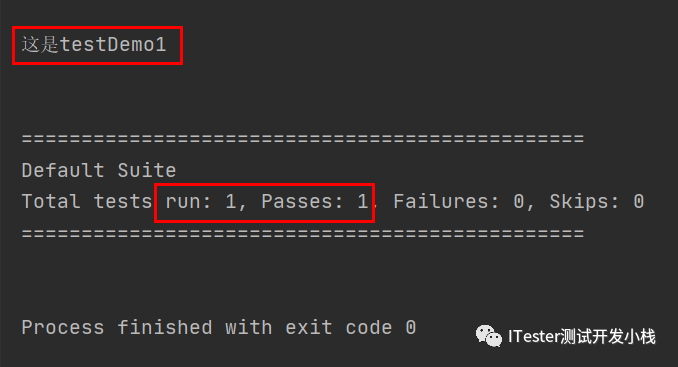Java接口自动化之TestNG单元测试框架(一)


本文3704字
阅读约需10分钟
上一篇Java接口自动化系列文章:Java接口自动化之log4j日志框架,主要介绍log4j日志介绍、日志三大组成部分及日志实战。
以下主要介绍TestNG的简介、@Test注解及其属性。
1 TestNG介绍
2 TestNG特点
支持注解;
灵活的运行配置;
支持多线程、忽略、异常、参数化等测试。
3 加入TestNG依赖
在maven项目的pom.xml中,添加内容如下:
org.testng
testng
7.0.0
@Test是TestNG 最基本的注解,用来将方法标注为测试方法。接下来会介绍@Test注解的常用属性。
1 enable 测试方法是否执行
enable默认是 true , 表示执行这个方法,如果设置为 false ,则在运行时不会执行这个测试方法。
import org.testng.annotations.Test;
public class TestDemo {
@Test(enabled = true)
public void testDemo1(){
System.out.println("这是testDemo1");
}
@Test(enabled = false)
public void testDemo2(){
System.out.println("这是testDemo2");
}
}
运行结果为:

从上图可以看出,enabled为true的方法执行了,enabled为false的方法未执行。
2 dependsOnMethods 依赖方法
在依赖的方法运行完成之后运行当前方法,如果依赖方法测试不通过,那么当前方法也不会继续运行了。
依赖的方法可以有多个,格式为:@Test(dependsOnMethods = { "method1" , “method2” })。
修改testDemo1代码,运行时抛出异常,代码如下:
import org.testng.annotations.Test;
public class TestDemo {
@Test()
public void testDemo1(){
int i=10;
System.out.println(i/0);
System.out.println("这是testDemo1");
}
@Test(dependsOnMethods = {"testDemo1"})
public void testDemo2(){
System.out.println("这是testDemo2");
}
}
运行结果为:

从上图可以看出testDemo1方法运行失败后,testDemo2方法被忽略运行了。
3 groups 分组
在运行时,一个组的方法会一起运行,然后再运行下一个组的方法;
格式为:@Test(groups = "groupName")。
import org.testng.annotations.Test;
import org.testng.annotations.BeforeGroups;
import org.testng.annotations.AfterGroups;
public class TestDemo {
@BeforeGroups(groups = "server")
public void beforeGroupsOnServer() {
System.out.println("服务端组运行前执行的方法。。。");
}
@BeforeGroups(groups = "client")
public void beforeGroupsOnClient() {
System.out.println("客户端组运行前执行的方法。。。");
}
@Test(groups = "server")
public void test1() {
System.out.println("server test1 run ....");
}
@Test(groups = "server")
public void test2() {
System.out.println("server test2 run ....");
}
@Test(groups = "client")
public void test3() {
System.out.println("client test3 run ....");
}
@Test(groups = "client")
public void test4() {
System.out.println("client test4 run ....");
}
@AfterGroups(groups = "server")
public void afterGroupsOnServer() {
System.out.println("服务端组运行之后执行的方法。。。");
}
@AfterGroups(groups = "client")
public void afterGroupsOnClient() {
System.out.println("客户端组运行之后执行的方法。。。");
}
}
运行结果为:
服务端组运行前执行的方法。。。
server test1 run ....
server test2 run ....
服务端组运行之后执行的方法。。。
客户端组运行前执行的方法。。。
client test3 run ....
client test4 run ....
客户端组运行之后执行的方法。。。
===============================================
Default Suite
Total tests run: 4, Failures: 0, Skips: 0
4 timeOut 超时属性
格式:@Test(timeOut = 3000) 设置超时时间,单位为毫秒。
import org.testng.annotations.Test;
public class TestDemo {
// 单位为毫秒值,3秒内没有响应,就运行失败,反之成功
@Test(timeOut = 3000)
public void testSuccess() throws InterruptedException {
Thread.sleep(2000);
}
// 单位为毫秒值,2秒内没有响应,就运行失败,反之成功
@Test(timeOut = 2000)
public void testFail() throws InterruptedException {
Thread.sleep(3000);
}
}
运行结果为:

从上图可以看出,testFail方法因为超时运行失败。
5 多线程测试
格式:@Test(invocationCount = 10,threadPoolSize = 3)。
参数说明:
invocationCount:线程调用的次数,默认1次。
threadPoolSize:线程池,需与invocationCount组合使用。
接下来编写一个方法,定义3个线程,执行方法10次。
import org.testng.annotations.Test;
public class TestDemo {
@Test(invocationCount = 10,threadPoolSize = 3)
public void testDemo(){
System.out.println("---------");
System.out.printf("Thread Id : %s%n",Thread.currentThread().getId());
}
}
运行结果为:
[TestNG] Running:
---------
---------
Thread Id : 13
---------
Thread Id : 12
Thread Id : 14
---------
Thread Id : 13
---------
Thread Id : 14
---------
Thread Id : 12
---------
Thread Id : 12
---------
Thread Id : 13
---------
Thread Id : 14
---------
Thread Id : 12
===============================================
Default Suite
Total tests run: 10, Failures: 0, Skips: 0
===============================================
(完)

喜欢记得星标置顶,让我们一起守护成长
